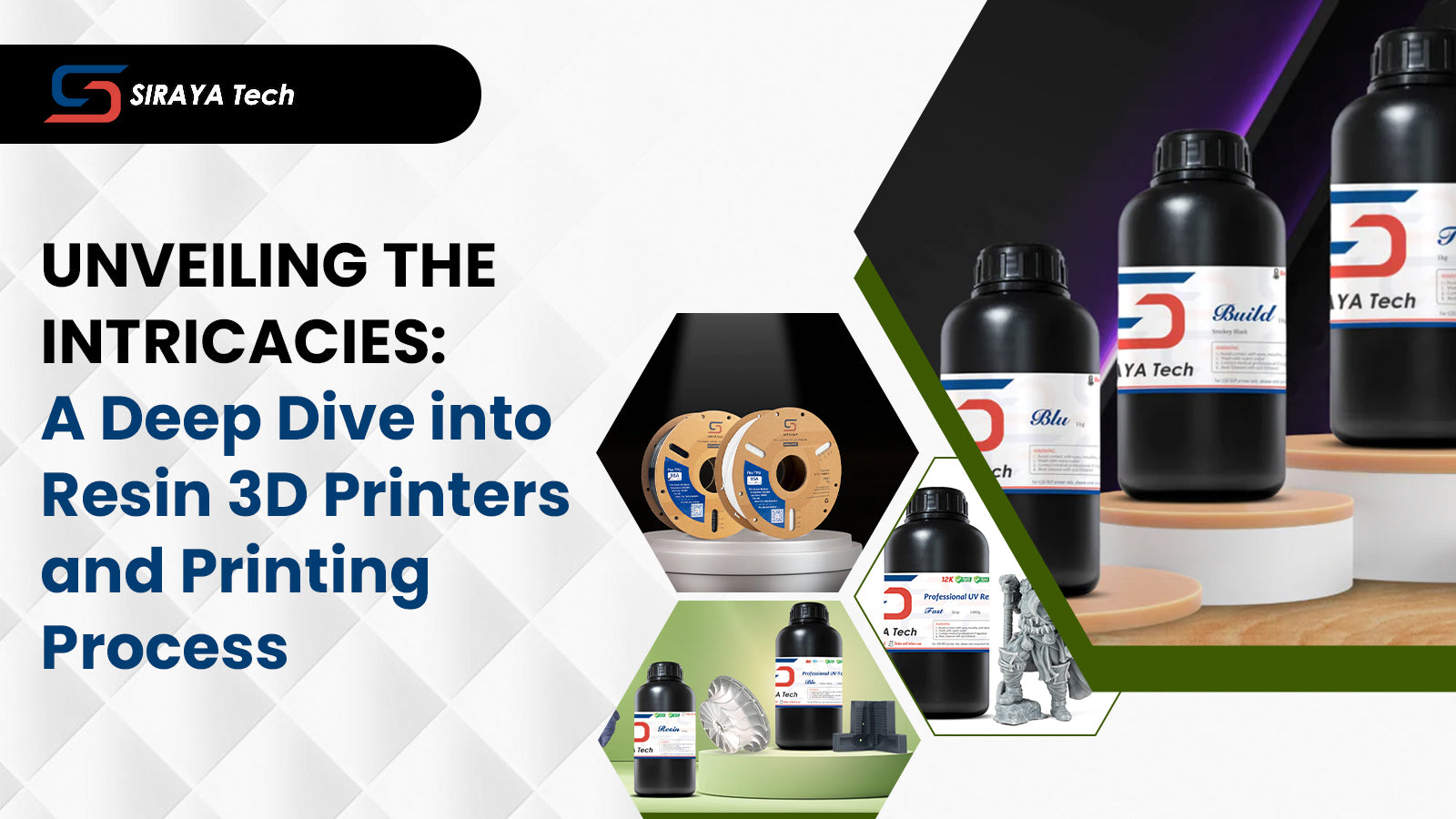レジンプリンターは、精巧なディテールと優れた仕上がりを備えた3Dモデルを作成するための不可欠な機械となっています。フィラメントベースのプリンターとは異なり、これらのプリンターは、Siraya樹脂の容器を使用して溶融プラスチックを層状に重ねることができます。Siraya樹脂は光で硬化するため、非常に滑らかな表面を完璧な精度で実現できます。このブログでは、レジン3Dプリンターの魅力を、その緻密な技術、メリット、そしてあなたの3Dプリントプロジェクトに最適な製品かどうかを判断するためのその他の考慮事項とともにご紹介します。
技術現象:樹脂印刷プロセスの紹介
あらゆるレジンプリンターの核となるのは、液体と光の魅惑的な相互作用です。このプロセスこそが、あなたの3Dアイデアを楽々と形にするのです。ここでは、3Dレジンプリンターの仕組みを分かりやすく解説するために、プロセスを段階的に分解していきます。
- デジタル設計:傑作を創造するための最初のステップは、コンピュータ支援設計(CAD)ソフトウェアを使用して3Dモデルを設計することから始まります。このデジタル設計図は、印刷されたモデルが実際にどのようになるかを詳細に示します。
- スライスと準備:専用のスライスソフトウェアは、3Dプリントを非常に薄い水平方向のレイヤーの連続に変換します。各レイヤーは、完成した3Dオブジェクトの断面を表します。印刷プロセスのこの段階では、レイヤーの高さ、サポート構造、印刷解像度などの他のパラメータも定義できます。
- タンクとビルドプラットフォーム: Lychee Slicer Proのようなレジンプリンターには、レジンタンクと呼ばれる液状フォトポリマー樹脂を充填する容器が備えられています。ビルドプラットフォームは、レジンに浸された状態で3Dモデルを構築するための土台として機能します。
- 光硬化:まさに魔法の瞬間です。高解像度LCDスクリーンまたはUVレーザーなどの光源が、レジンタンクの底部に最初の層の正確な画像を投影します。この光によって、タンク内の対応するレジンが固まり(硬化)、ビルドプラットフォームに接着されます。
- レイヤーごとの造形:ビルドプラットフォームは、プログラムされたレイヤーの高さだけレジンタンクから上昇します。光源から次々にレイヤーイメージが投影され、前のレイヤーの上に別のレジン層が固まります。phrozen mini 8kは、このサイクルを繰り返し、レイヤーごとにイメージ全体が構築されるまで続けます。
- 後処理:プリントプロセスが完了すると、ビルドプラットフォームがレジンタンクから取り出されます。プリントされたモデルは後処理が必要となり、サポート構造を慎重に取り外し、IPA(イソプロピルアルコール)で余分なレジンを徹底的に除去し、オブジェクト全体をUVライトで硬化させて効果的に固める必要があります。
細部へのこだわり:樹脂プリントのメリットを明らかに
レジンプリントは、その緻密な造形により、非常に精巧な3Dモデルの作成を可能にするという点で際立っています。また、複雑なデザインのプロジェクトも容易に進めることができるなど、クリエイターにとって様々なメリットをもたらします。ここでは、レジンプリントがクリエイターにもたらす具体的なメリットをいくつかご紹介します。
- 比類のない解像度: フローズンSonic Mega 8kのようなレジンプリンターは、25ミクロンという低解像度を実現できます。これは、フィラメントベースの3Dプリンターを大幅に上回ります。この性能により、非常に精細なディテールを持つ高精細モデルの作成が可能になり、ジュエリー製作やミニチュア製作に最適です。
- 優れた表面仕上げ:フィラメントプリントでは層状の凹凸が目立ちますが、樹脂プリントではほぼ等方性の仕上がりで非常に滑らかな表面を実現。つまり、造形物の特性はあらゆる方向で一定です。そのため、洗練された外観を得るための後処理工程を煩雑に行う必要がありません。
- 多様な樹脂:レジン3Dプリントは、様々なニーズに応える多様な樹脂素材を誇ります。最終的な3Dプリントに求める特性に応じて、鋳造可能なSiraya樹脂またはフレキシブルなSiraya樹脂のいずれかをお選びいただけます。
- 機能プロトタイプ:高い精度と多様な材料オプションを備えた樹脂プリントは、製品開発における機能プロトタイプの作成に最適です。フローズン・ソニック・ミニ8Kなどのプリンターで製造されたプロトタイプは、形状と機能の両面で最終製品に非常によく似ています。
仕事に適したツールの選択:重要な考慮事項
レジン3Dプリントは、複雑なデザインを簡単に作成できるため、3Dプリントの作成において様々なメリットをもたらします。しかし、3Dプリントプロジェクトを楽しむためには、この冒険を始める前に以下の要素を考慮する必要があります。
- 作業スペースの設定:液体レジンは皮膚や目に刺激を与える可能性があります。プリント中の蒸気への曝露を減らすため、適切に換気された作業スペースを確保し、安全メガネ、防毒マスク、手袋などの個人用保護具(PPE)を着用してください。Sirayaレジンの廃棄や取り扱いの際は、メーカーが提供する安全に関する指示に必ず従ってください。
- 後処理:レジンプリントの後処理は、フィラメントプリントよりも少し複雑になる場合があります。後処理で最適な結果を得るには、IPAなどの溶剤を使用してモデルを洗浄し、紫外線で固めてください。
- レジンのコスト:レジンはフィラメントに比べて1キログラムあたりの価格が高くなります。しかし、レジンプリントでは精細な造形と材料の無駄を最小限に抑えられるため、このコストを相殺できる場合が多いです。
- メンテナンス: 樹脂プリンターは、樹脂の蓄積を防ぎ、適切な動作を確保するために、バットと印刷プラットフォームの清掃を含む定期的なメンテナンスが必要です。
成功のための準備:レジンプリントに必須のギア
レジン3Dプリントの重要な側面を理解したので、コースで役立つツールの種類を知っておくとよいでしょう。以下のツールを準備しておくと便利です。
- レジン3Dプリンター: 3Dレジンプリンターは、あなたのセットアップに欠かせない要素です。予算、希望する印刷サイズ、解像度などの要素に応じて選択してください。人気のある選択肢としては、趣味用のデスクトッププリンターや、プロフェッショナル用途向けの大型産業用プリンターなどがあります。
- 樹脂:前述の通り、樹脂には様々な種類があります。初心者の方はまず標準的な樹脂から始めるのが良いでしょうが、特定のニーズに合わせて、鋳造用樹脂、フレキシブル樹脂、エンジニアリング樹脂など、他の選択肢を検討することもできます。
- 硬化ステーション: 専用の UV 硬化ステーションにより、印刷されたオブジェクトが完全に硬化し、最適な強度と耐久性が得られます。
結論:樹脂印刷で創造性を解き放つ
レジン3Dプリンターは、多様な素材の選択肢、卓越した表面仕上げ、そして比類のないディテールを巧みに組み合わせた魅力的な製品です。これらのマシンの印刷技術は革新的で、安全性の向上や後処理の容易さなど、様々な利点を備えており、様々なクリエイティブ分野やタスクに最適です。経験豊富なアーティスト、起業家、あるいはアート制作に情熱を注ぐ個人など、あらゆる方にとって、 3D Printing Anycubicのようなプリンターは、ユニークなアイデアを壮大な現実へと変える力となります。

